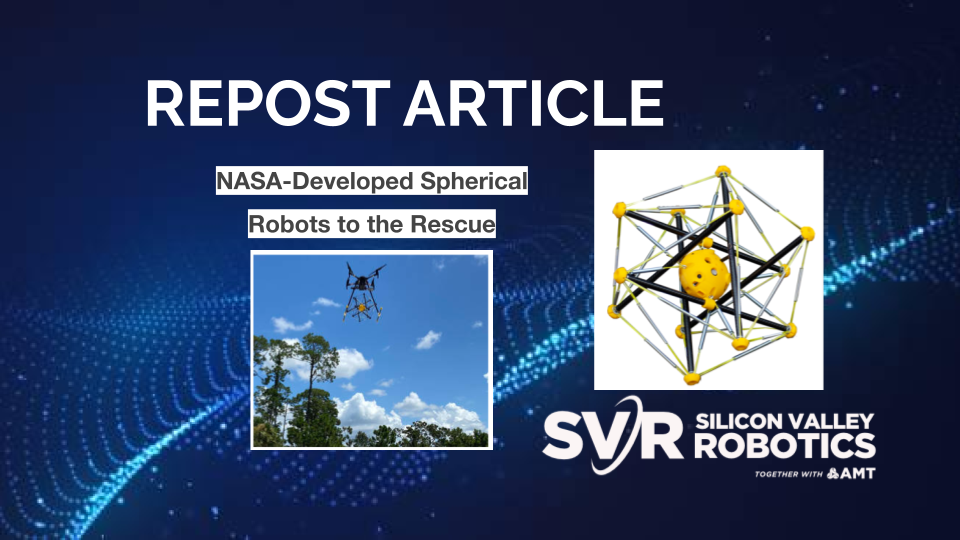Dr. Alice Agogino was researching spherical, skeletal robots that might one day be dropped onto Mars or the Moon to collect information and conduct science, when she realized her NASA-funded technology could have terrestrial benefits too.
Reading a report on the dangers and death toll of disaster response, Agogino thought her robots, fitted with the right sensors, could gather data at the scenes of fires, crashes, and other disasters to help first responders assess dangers like toxic gas leaks and plan their approach.
We thought, wow, if we can do this on the Moon, we could do it on Earth and save some lives,” said Agogino, who was then director of the Berkeley Emergent Space Tensegrities Lab at the University of California, Berkeley.
She went on to cofound Berkeley, California-based Squishy Robotics Inc. The company makes impact-resistant, customizable robots for public safety, military, and industrial uses.
Agogino’s robots look like ball-shaped skeletons of rods and elastic cables. She describes the structure as “a tension network” – if a robot is dropped, the impact is distributed across the network, dissipating the force, according to the principle of tensegrity.
The term tensegrity – short for tensile integrity – was coined in the 1960s by architect R. Buckminster Fuller, who popularized geodesic domes, which are also tensegrity structures.
For NASA, the ability to withstand the impact of a long drop is especially interesting, as is the ability of these structures to collapse into a small package during travel.
The agency awarded Agogino and her UC Berkeley lab Early Stage Innovations (ESI) funding in 2014 to research tensegrity robot mobility using gas thrusters.
The $500,000, multi-year, proof-of-concept ESI grants aim to accelerate the development of innovative space technologies that have significant potential. The funding is offered through the Space Technology Research Grants program, which supports academic researchers working on space-related science and technology.
Agogino and her team were designing probes that could drop from a planetary orbit or larger spacecraft, survive the drop carrying delicate sensors, and then roll and jump over rough terrain to perform missions and science on other worlds.“Think about the Mars Curiosity and Perseverance rovers,” said Terry Fong, chief roboticist in the Intelligent Robotics Group at NASA’s Ames Research Center in California’s Silicon Valley.
Fong, who was NASA’s technical representative for Agogino’s grant, explained that the rovers had to be gently lowered to Mars’ surface with the elaborate Sky Crane system.
“With tensegrity robots, the robot itself is the landing device,” Fong said. “It could survive a fall from very high up and keep going.”
The tensegrity devices can be folded flat for travel — in fact, that’s how Agogino ships robots to customers. Once they unfurl, the instruments and sensors are suspended in the center, protected from the impact of a fall.
“So, you save on throwaway mass,” Fong said. “It’s expensive and difficult to launch mass into space, so you want more of it to be used beyond landing, on the surface with scientific instrumentation and other payloads.”
NASA also researched Earth science applications for tensegrity robots, which could monitor, for instance, a glacier that’s about to break off into the ocean.
“That’s the kind of place you would not want to send a person, because it’s very risky,” Fong said. “The whole surface could collapse. With a structure that could survive a drop but still be mobile afterwards, you would have a super instrument positioning system.”
On Earth or on other planets, tensegrity robots offer an easier way to place delicate instruments into difficult-to-reach areas. Indeed, that’s the principle behind Squishy Robotics.
Agogino and her team interviewed 300 first responders in a process known as customer discovery.
For these customers, Squishy Robotics now puts miniaturized chemical gas sensors inside the tensegrity robot that can be dropped by aircraft to take readings in an area before firefighters go in. Currently, the company only offers stationary robots, but Agogino and her team are working on mobile models.
The data these robots collect can inform firefighters’ decisions about whether to wear hazardous material gear, which can add up to an hour of prep time — a delay that’s only worthwhile if it’s necessary.
Squishy Robotics has worked with some of the largest fire departments, including Southern Manatee Fire and Rescue in Florida, the Tulsa Fire Department in Oklahoma, and the San Jose Fire Department in California. The company has also established reseller agreements with several distributors.
Agogino’s tensegrity robots could also help defuse bombs or monitor gas and electric lines.
Wildfire prevention is another emerging area for Squishy Robotics. Tensegrity robots could monitor high-risk areas, help authorities respond to reports, and ensure that smaller fires have been fully extinguished.
“The early detection of wildfires is critical,” Agogino says, “because so many of the wildfires that have become raging firestorms could have been prevented if they had been caught early.”
Agogino is now emeritus, having retired in December from Berkeley, which allows her to spend more time on Squishy Robotics.
NASA’s Fong said he was happy to see Agogino was able to spin off the tensegrity robot technology. “We believe these robots could serve unique purposes for space,” he said. “She obviously saw a way to also have a major impact on Earth.”
NASA has a long history of transferring technology to the private sector. The agency’s Spinoff publication profiles NASA technologies that have transformed into commercial products and services, demonstrating the broader benefits of America’s investment in its space program. Spinoff is a publication of the Technology Transfer program in NASA’s Space Technology Mission Directorate (STMD).
For more information on how NASA brings space technology down to Earth, visit:
By Rebecca Carroll
NASA’s Spinoff Publication



